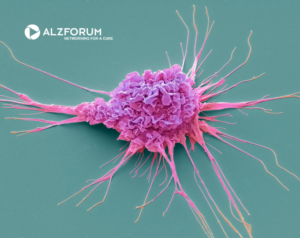 As Aβ plaques accumulate in the brain, microglia are increasingly called upon to clean up the mess. This relentless phagocytic feasting requires enormous amounts of energy in the form of adenosine triphosphate, but by boosting glycolysis, the microglia [1] fail to provide enough ATP, according to a study published October 6 in Nature Metabolism. Scientists led by Jie Zhang, Xiamen University in China, reported that hexokinase 2—a pivotal enzyme in glucose metabolism—ramps up in microglia in the AD brain. Curiously, deleting or inhibiting HK2 in mouse models of amyloidosis boosted microglial ATP production. The cells mustered the extra energy by transforming into fat-burning machines, the scientists found. They cranked up expression of lipoprotein lipase and other lipid metabolism genes. These lipid-utilizing microglia were supreme consumers of Aβ plaques and other neuronal debris, and spared AD mice from memory loss. The findings support the idea that metabolic shifts and functional states in microglia are intimately intertwined.
As Aβ plaques accumulate in the brain, microglia are increasingly called upon to clean up the mess. This relentless phagocytic feasting requires enormous amounts of energy in the form of adenosine triphosphate, but by boosting glycolysis, the microglia [1] fail to provide enough ATP, according to a study published October 6 in Nature Metabolism. Scientists led by Jie Zhang, Xiamen University in China, reported that hexokinase 2—a pivotal enzyme in glucose metabolism—ramps up in microglia in the AD brain. Curiously, deleting or inhibiting HK2 in mouse models of amyloidosis boosted microglial ATP production. The cells mustered the extra energy by transforming into fat-burning machines, the scientists found. They cranked up expression of lipoprotein lipase and other lipid metabolism genes. These lipid-utilizing microglia were supreme consumers of Aβ plaques and other neuronal debris, and spared AD mice from memory loss. The findings support the idea that metabolic shifts and functional states in microglia are intimately intertwined.
- In the AD brain, microglia boost expression of the glycolytic enzyme hexokinase 2.
- Blocking HK2 in mice improved microglial phagocytosis and plaque clearance.
- HK2 inhibition switched on lipid metabolism, boosting ATP production.
“This new report is an exciting new addition to a growing number of studies implicating the regulation of microglia metabolism as a central driver in Alzheimer’s disease pathogenesis,” commented Lance Johnson of the University of Kentucky in Lexington.
Russell Swerdlow of Kansas University Medical Center in Kansas City wrote that the study answers important questions while raising many others. “I certainly hope it will help to further focus the field on the relevance of energy metabolism in AD, whether it is in neurons, astrocytes, or microglia.”